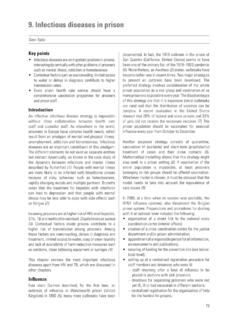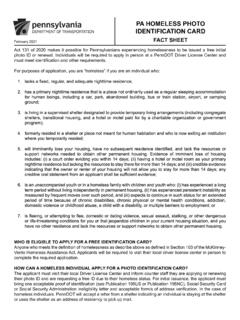Transcription of The McKinney-Vento Homeless Assistance Act As …
1 The McKinney-Vento Homeless Assistance Act As amended by S. 896 The Homeless Emergency Assistance and Rapid Transition to Housing (HEARTH) Act of 2009 1 SEC. 103. [42 USC 11302]. GENERAL DEFINITION OF Homeless INDIVIDUAL. (a) IN GENERAL. For purposes of this Act, the term Homeless , Homeless individual , and Homeless person means (1) an individual or family who lacks a fixed, regular, and adequate nighttime residence; (2) an individual or family with a primary nighttime residence that is a public or private place not designed for or ordinarily used as a regular sleeping accommodation for human beings, including a car, park, abandoned building, bus or train station, airport, or camping ground; (3) an individual or family living in a supervised publicly or privately operated shelter designated to provide temporary living arrangements (including hotels and motels paid for by Federal, State, or local government programs for low-income individuals or by charitable organizations, congregate shelters, and transitional housing); (4) an individual who resided in a shelter or place not meant for human habitation and who is exiting an institution where he or she temporarily resided.
2 (5) an individual or family who (A) will imminently lose their housing, including housing they own, rent, or live in without paying rent, are sharing with others, and rooms in hotels or motels not paid for by Federal, State, or local government programs for low-income individuals or by charitable organizations, as evidenced by (i) a court order resulting from an eviction action that notifies the individual or family that they must leave within 14 days; (ii) the individual or family having a primary nighttime residence that is a room in a hotel or motel and where they lack the resources necessary to reside there for more than 14 days; or (iii) credible evidence indicating that the owner or renter of the housing will not allow the individual or family to stay for more than 14 days, and any oral statement from an individual or family seeking Homeless Assistance that is found to be credible shall be considered credible evidence for purposes of this clause; (B) has no subsequent residence identified; and (C) lacks the resources or support networks needed to obtain other permanent housing; and The McKinney-Vento Homeless Assistance Act As amended by S.
3 896 The Homeless Emergency Assistance and Rapid Transition to Housing (HEARTH) Act of 2009 2 (6) unaccompanied youth and Homeless families with children and youth defined as Homeless under other Federal statutes who-- (A) have experienced a long term period without living independently in permanent housing, (B) have experienced persistent instability as measured by frequent moves over such period, and (C) can be expected to continue in such status for an extended period of time because of chronic disabilities, chronic physical health or mental health conditions, substance addiction, histories of domestic violence or childhood abuse, the presence of a child or youth with a disability, or multiple barriers to employment. (b) DOMESTIC VIOLENCE AND OTHER DANGEROUS OR LIFE-THREATENING CONDITIONS.
4 Notwithstanding any other provision of this section, the Secretary shall consider to be Homeless any individual or family who is fleeing, or is attempting to flee, domestic violence, dating violence, sexual assault, stalking, or other dangerous or life-threatening conditions in the individual's or family's current housing situation, including where the health and safety of children are jeopardized, and who have no other residence and lack the resources or support networks to obtain other permanent housing. (c) INCOME ELIGIBILITY. (1) IN GENERAL. A Homeless individual shall be eligible for Assistance under any program provided by this Act, only if the individual complies with the income eligibility requirements otherwise applicable to such program. (2) EXCEPTION.
5 Notwithstanding paragraph (1), a Homeless individual shall be eligible for Assistance under title I of the Workforce Investment Act of 1998. (d) EXCLUSION. For purposes of this Act, the term Homeless or Homeless individual does not include any individual imprisoned or otherwise detained pursuant to an Act of the Congress or a State law. (e) PERSONS EXPERIENCING homelessness . Any references in this Act to Homeless individuals (including Homeless persons) or Homeless groups (including Homeless persons) shall be considered to include, and to refer to, individuals experiencing homelessness or groups experiencing homelessness , respectively. SEC. 104. [42 USC 11303]. FUNDING AVAILABILITY AND LIMITATIONS. (a) CALCULATION. The amounts authorized in this Act shall be in addition to any amount appropriated for the programs involved before July 22, 1987.
6 The McKinney-Vento Homeless Assistance Act As amended by S. 896 The Homeless Emergency Assistance and Rapid Transition to Housing (HEARTH) Act of 2009 3 (b) AVAILABILITY UNTIL EXPENDED. Any amount appropriated under an authorization in this Act shall remain available until expended. (c) LIMITATION. Appropriations pursuant to the authorizations in this Act shall be made in accordance with the provisions of the Congressional Budget and Impoundment Control Act of 1974, which prohibits the consideration of any bill that would cause the deficit to exceed the levels established by the Balanced Budget and Emergency Deficit Control Act of 1985, such that it shall not increase the deficit of the Federal Government for fiscal year 1987. SEC. 105. [42 USC 11304].
7 PROGRAM SUMMARY BY COMPTROLLER GENERAL. The Comptroller General of the United States may evaluate the disbursement and use of the amounts made available by appropriation Acts under the authorizations in titles III and IV of. TITLE IV HOUSING Assistance SUBTITLE A GENERAL PROVISIONS SEC. 401. DEFINITIONS. For purposes of this title: (1) AT RISK OF homelessness . The term `at risk of homelessness ' means, with respect to an individual or family, that the individual or family (A) has income below 30 percent of median income for the geographic area; (B) has insufficient resources immediately available to attain housing stability; and (C)(i) has moved frequently because of economic reasons; (ii) is living in the home of another because of economic hardship; (iii) has been notified that their right to occupy their current housing or living situation will be terminated; (iv) lives in a hotel or motel; (v) lives in severely overcrowded housing; (vi) is exiting an institution; or (vii) otherwise lives in housing that has characteristics associated with instability and an increased risk of homelessness .
8 The McKinney-Vento Homeless Assistance Act As amended by S. 896 The Homeless Emergency Assistance and Rapid Transition to Housing (HEARTH) Act of 2009 4 Such term includes all families with children and youth defined as Homeless under other Federal statutes. (2) CHRONICALLY Homeless . (A) IN GENERAL. The term `chronically Homeless ' means, with respect to an individual or family, that the individual or family (i) is Homeless and lives or resides in a place not meant for human habitation, a safe haven, or in an emergency shelter; (ii) has been Homeless and living or residing in a place not meant for human habitation, a safe haven, or in an emergency shelter continuously for at least 1 year or on at least 4 separate occasions in the last 3 years.
9 And (iii) has an adult head of household (or a minor head of household if no adult is present in the household) with a diagnosable substance use disorder, serious mental illness, developmental disability (as defined in section 102 of the Developmental Disabilities Assistance and Bill of Rights Act of 2000 (42 15002)), post traumatic stress disorder, cognitive impairments resulting from a brain injury, or chronic physical illness or disability, including the co-occurrence of 2 or more of those conditions. (B) RULE OF CONSTRUCTION. A person who currently lives or resides in an institutional care facility, including a jail, substance abuse or mental health treatment facility, hospital or other similar facility, and has resided there for fewer than 90 days shall be considered chronically Homeless if such person met all of the requirements described in subparagraph (A) prior to entering that facility.
10 (3) COLLABORATIVE APPLICANT. The term `collaborative applicant' means an entity that (A) carries out the duties specified in section 402; (B) serves as the applicant for project sponsors who jointly submit a single application for a grant under subtitle C in accordance with a collaborative process; and (C) if the entity is a legal entity and is awarded such grant, receives such grant directly from the Secretary. (4) COLLABORATIVE APPLICATION. The term `collaborative application' means an application for a grant under subtitle C that (A) satisfies section 422; and (B) is submitted to the Secretary by a collaborative applicant. The McKinney-Vento Homeless Assistance Act As amended by S. 896 The Homeless Emergency Assistance and Rapid Transition to Housing (HEARTH) Act of 2009 5 (5) CONSOLIDATED PLAN.

















